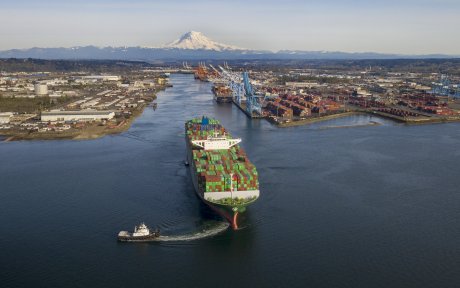The Northwest ports of Vancouver, British Columbia, Tacoma, Seattle, and the combined container operations of The Northwest Seaport Alliance, have announced their new vision to phase out emissions from seaport-related activities by 2050.
In a collaboration among the four ports, the Northwest Ports Clean Air Strategy seeks to meet this target through changes in equipment, fuels, and infrastructure, supporting cleaner air for local communities and fulfilling the ports’ shared responsibility to help limit the global temperature rise to 1.5degs C.
[s2If is_user_logged_in()]”It’s essential that the state and federal government partner with the ports in order to provide progressive policies and financial assistance that create incentives for their adoption prior to regulatory obligations,” said Fred Felleman, Port of Seattle commission president and co-chair of The Northwest Seaport Alliance.
The ports recognise the urgency of the climate crisis and the need to reduce diesel emissions, especially in areas where air quality is poor while ensuring their continuity and competitiveness.
Engagement across the ports, industry, government, and communities shaped the strategy vision and objectives, which cover six sectors of port activity: oceangoing vessels, cargo-handling equipment, trucks, harbour vessels, rail, and port administration and tenant facilities.
“Through the Northwest Ports Clean Air Strategy, ports have a blueprint to do their part by helping to protect air quality and responding to the international call to take action on climate change,” commented Dick Marzano, Port of Tacoma commission president and co-chair of The Northwest Seaport Alliance.
In addition, Robin Silvester, president and chief executive officer of the Vancouver Fraser Port Authority, noted that the Port of Vancouver is “committed to supporting the Government of Canada’s goal of achieving net-zero emissions by 2050,” and he went on to say, “The Northwest Ports Clean Air Strategy is a key part of our efforts to advance the clean energy transition.”
Recent data suggests that greenhouse gas (GHG) emissions from international shipping are increasing, not decreasing, while according to the International Maritime Organization, GHG emissions from shipping increased 10% between 2012 and 2018 and are projected to increase by another 50% by 2050 if no additional actions are taken.
The Northwest Ports will each release port-specific plans to implement the 2020 Strategy vision and objectives across their unique operations and businesses and will continue to report annually on the progress.
Finally, the ports believe they cannot achieve this vision alone and the Northwest Ports look forward to continuing to collaborate with industry, governments, non-profits, communities, and other ports and partners to implement the strategy and advance toward a zero-emissions future.
[/s2If]
[s2If !is_user_logged_in()]Please login or register to read the rest of the story[/s2If]







